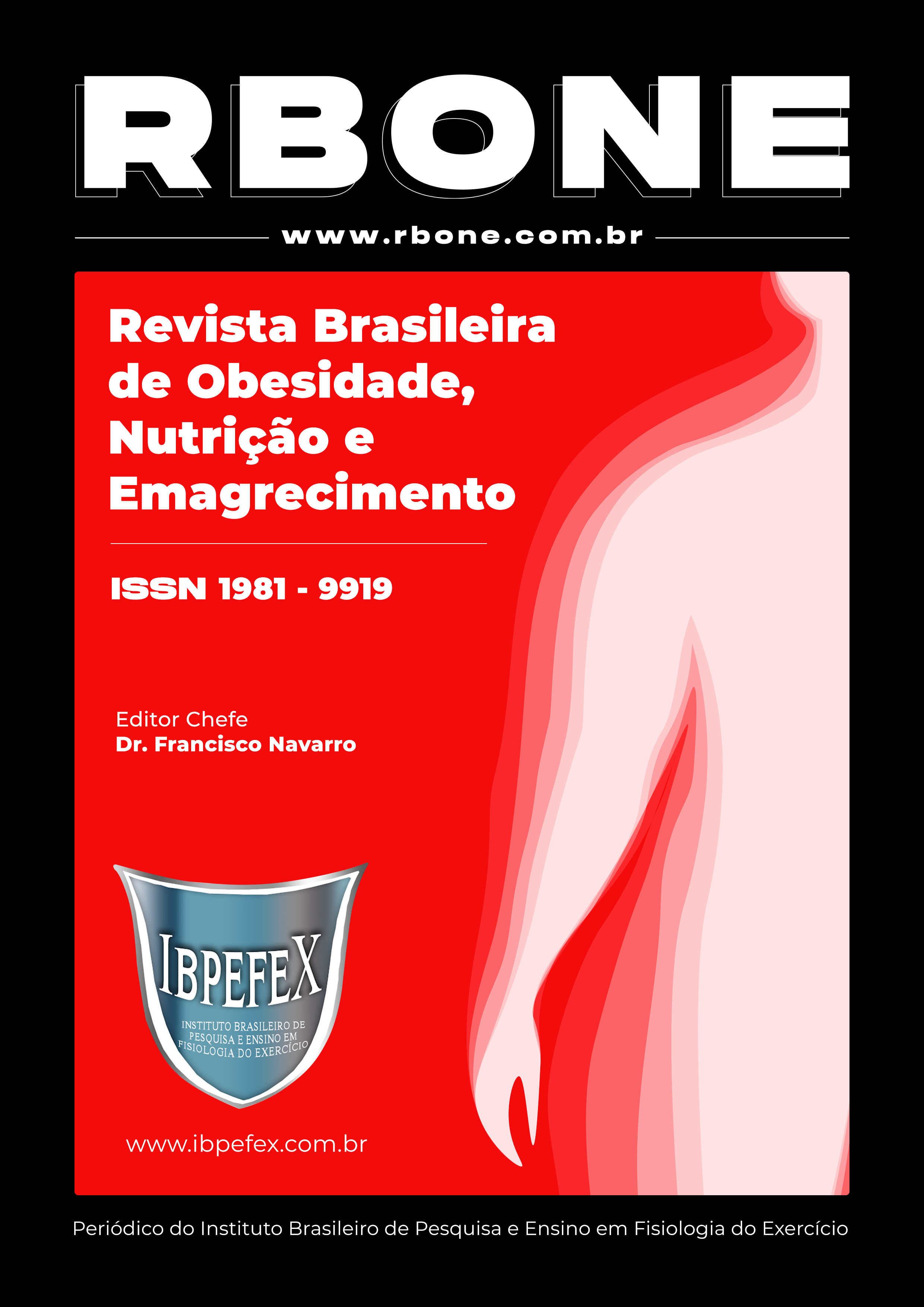Overweight and obesity in children aged six to nine years: World Health Organization reference curves
Abstract
Introduction: The occurrence of overweight has increased in recent decades among children and adolescents from various regions of the world. The health damage that overweight and obesity entails, increase the importance of diagnosis in young people. Objective: To construct and compare a specific body mass index (BMI) curve for children aged six to nine years with the normative values of the World Health Organization of 2007 and to show nutritional diagnosis by classifying the percentiles. Materials and Methods: Non-probabilistic cross-sectional study for convenience. The sample consisted of 800 children with simple randomized pairing by sex, performed in Porto Velho-RO, 2018. Weight and height measurements were performed to calculate BMI (kg/m2). The LMS method was used to construct the curves. Results: I) Most children in the male group presented values in each percentile higher than the female group. II) The prevalence of obesity was higher in boys at all ages from six to nine years. III) Bmi percentiles for children aged six to nine years showed higher normative values for both sexes from the P50 percentile when viewed with the world health organization reference percentiles of 2007. Conclusion: Boys from six to nine years of age were more overweight than girls. Therefore, local, and population-specific BMI curves should be developed to assess the growth of children.
References
-Cole, T.J.; Green, P.J. Smoothing reference centile curves: the LMS method and penalized likelihood. Stat Med. Vol. 11. 1992. https://doi.org/10.1002/sim.4780111005
-Coutinho, W. Consenso Latino-americano de obesidade. Arq Bras Endocrinol Metab. Vol. 43. Núm.1. 1999. p. 21-60. https://doi.org/10.1590/ S0004-27301999000100003
-Ferreira, A.P.S.; Szwarcwald, C.L.; Damacena, G.N. Prevalência e fatores associados da obesidade na população brasileira: estudo com dados aferidos da Pesquisa Nacional de Saúde, 2013. Rio de Janeiro-RJ, Brasil. Revista Brasileira Epidemiológica. Vol. 22. 2019. https://doi.org/10.1590/1980-549720190 024
-Freitas, A.I.; Moreira, C.; Santos, A.C.; Temporal evolution of prevalences and incidence rates of overweight and obesity in childhood in Portugal: birth cohort of the XXI generation. Int J Obe. Vol. 43. Num. 2. 2019. p. 424-427.
-Huang, F.; Zhang, M.; Li, Y.; Li, Z.; Fang, J.; Guo, K. The longitudinal trajectory of body mass index in the Chinese population: A latent growth curve analysis. PLoS One. Vol. 26. Num. 13. 2018. https://doi.org/10.1371/journal.pone. 0207845
-IBGE. Instituto Brasileiro de Geografia e Estatística. Pesquisa de orçamentos familiares 2002-2003. Antropometria e análise do estado nutricional de crianças e adolescentes. Temporal evolution of prevalences and incidence rates of overweight and obesity in childhood in Portugal: birth cohort of the XXI generation no Brasil. Rio de Janeiro. 2006.
-Liria, R. Consecuencias de la obesidad en el niño y el adolescente: un problema que requiere atención. Rev. perú. med. exp. salud publica. Vol. 29. Num. 3. 2012. p. 357-360.
-Lohman, T.; Roche, A.; Martorell, R. Anthropometric standardization reference manual. Champaign, IL, USA: Human Kinetics. 1988.
-Oliveira, C.L.; Fisberg, M. Obesidade na infância e adolescência uma verdadeira epidemia. Arq Bras Endócrino Metabol. Vol. 47. Num. 2. 2003. p. 107-182. https://doi.org/10.1 590/S0004-27302003000200001
-OMS. Organização Mundial da Saúde. Growth reference data for 5-19 years. WHO, Reference 2007. Disponível em: https://www.who.int /toolkits/growth-reference-data-for-5to19-years. Acesso em: 14/04/2021.
-Onis, M.; Onyango, A.W.; Borghi, E.; Siyam, A.; Nishida, C.; Siekmann, J. Development of a WHO growth reference for school-aged children and adolescents. Bulletin of the World Health Organization. Vol. 85. Num. 9. 2007. https://doi.org/10.2471/blt.07.043497
-Regecová, V.; Hamade, J.; Janechová, H.; Ševčíková, Ľ. Comparison of Slovak reference values for anthropometric parameters in children and adolescents with international growth standards: implications for the assessment of overweight and obesity. Croat Med. J. Vol. 59. Num. 6. 2018. p. 313-326. https://doi.org/10.3325/cmj.2018.59.313
-UN News. United Nations. Counselling and dieting among new UN health agency guidelines on child obesity. 2017. Disponível em: https://news.un. org/en/story/2017/10/567772#collapseOne. Acesso em: 13/05/2019.
-Wijnhoven, T.M.; Van Raaji, J.M.A.; Spinelli, A.; Rito, A.I.; Hovengen, R.; Kunesova, M.; Starc, G.; Rutter, H.; Sjöberg, A.; Petrauskiene, A.; O’Dwyer, U.; Petrova, S.; Farrugia Sant’Angelo, V.; Wauters, M.; Yngve, A.; Rubana, I. M.; Breda, J. Iniciativa Europeia de Vigilância da Obesidade Infantil da OMS: índice de massa corporal e nível de sobrepeso entre crianças de 6 a 9 anos, do ano escolar de 2007/2008 ao ano letivo de 2009/2010. BMC Public Health. Vol. 14. 2014. https://doi.org/10.1111/j.2047-6310.2012.00 090.x
-WHO. World Health Organization. Physical status: the use and interpretation of anthropometry. Report of the WHO Expert Committee. WHO technical report series 854. 1995. Disponível em: https://www.who.int/ publications/i/item/9241208546. Acesso em: 10/05/2019.
-WHO. World Health Organization. World Health Statistics 2018: monitoring health for the SDGs, sustainable development goals. Geneva: World Health Organization; 2018. Disponível em: https://www.who.int/publications/i/item/97 89241565585. Acesso em 16/05/2018.
-Yáñez-Ortega, J.L.; Arrieta-Cerdán, E.; Lozano-Alonso, J.E.; Costa, M.G.; Gutiérrez-Araus, A.M.; Cordero-Guevara, J.A.; Alonso, T.V. Prevalencia de sobrepeso y obesidad infantil: Estudio de una cohorte en Castilla y León, España. Endocrinología, Diabetes y Nutrición. Vol. 66. Núm. 3. 2019. p. 173-180. https://doi.org/10.1016/j.endinu.2018.10. 004
Copyright (c) 2025 Manuela Havena Rosendo Lopes, Flavio Yoshio Nanami, Josivana Pontes dos Santos, Edson dos Santos Farias

This work is licensed under a Creative Commons Attribution-NonCommercial 4.0 International License.
Authors who publish in this journal agree to the following terms:
- Authors retain the copyright and grant the journal the right of first publication, with work simultaneously licensed under the Creative Commons Attribution License BY-NC which allows the sharing of the work with acknowledgment of the authorship of the work and initial publication in this journal.
- Authors are authorized to enter into additional contracts separately for non-exclusive distribution of the version of the work published in this journal (eg, publishing in institutional repository or book chapter), with acknowledgment of authorship and initial publication in this journal.
- Authors are allowed and encouraged to post and distribute their work online (eg, in institutional repositories or on their personal page) at any point before or during the editorial process, as this can bring about productive change as well as increase impact and impact. citation of published work (See The Effect of Free Access).






